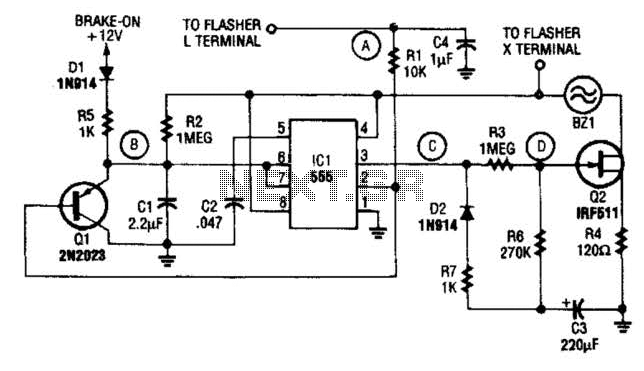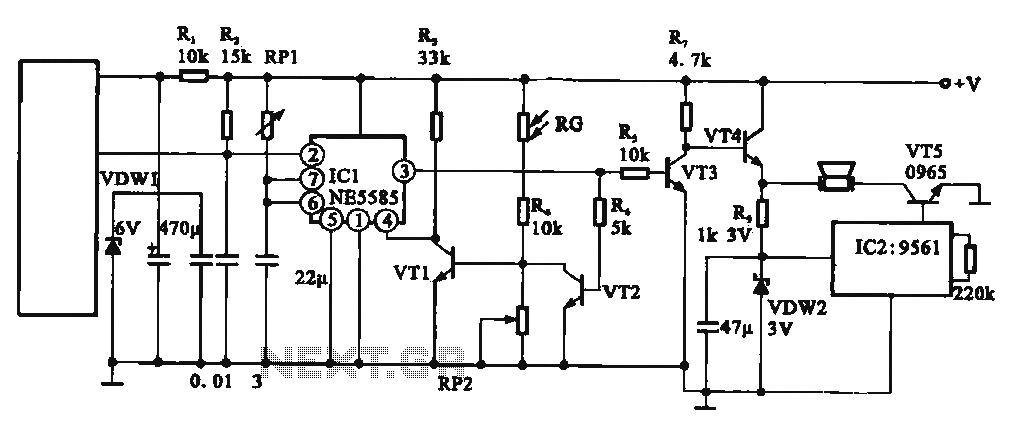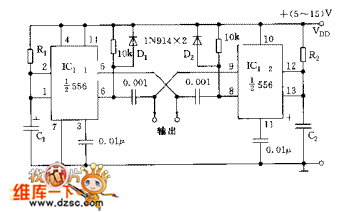
Smart Turn Signal Circuit

The STS schematic illustrates a circuit designed to alert a driver when the turn signal has been active for more than 15 seconds. The voltage at the gate of transistor Q2 increases in response to the charge accumulated on capacitor C3. After a 15-second charging period, the buzzer emits a warbling sound, which intensifies as charging continues. Circuit waveforms indicate that point A receives the signal from the flasher, while the voltage at point D rises as long as the output at pin 3 of IC1 (point C) remains high. The time constant determined by capacitor C1 and resistor R2 (point B) influences the duration for which the output stays high. Flasher terminal L is connected to the load, and terminal X is connected to a 12-volt power supply. When the turn signal is activated, the voltage at terminal L fluctuates in correspondence with the blinking lights. The STS circuit detects this voltage variation and, after 15 seconds, energizes a buzzer through a current-limiting device to regulate its volume. Additionally, when the vehicle is stopped at a traffic light, the brake-on signal temporarily disables the warning system.
The STS circuit serves as an essential reminder for drivers to turn off their turn signals, thereby enhancing road safety. The operation begins with the charging of capacitor C3, which is influenced by the signal from the turn signal flasher circuit. The gradual increase in voltage at the gate of Q2 allows it to switch on, initiating the buzzer activation sequence after the predetermined time interval.
The circuit's design incorporates key components such as the integrated circuit IC1, which is responsible for generating the timing signal, and the C1-R2 combination that sets the time constant for the output signal duration. The design ensures that the buzzer's loudness can be controlled through a current-limiting resistor, allowing for a customizable warning sound that is audible but not overly disruptive.
The connection points within the circuit, including point A for the flasher signal, point C for the IC output, and point D for the voltage monitoring, are strategically placed to facilitate easy troubleshooting and integration into existing vehicle electrical systems. The use of a brake-on signal to disable the buzzer when the vehicle is stationary is a thoughtful inclusion that prevents unnecessary distractions for the driver.
Overall, the STS circuit exemplifies a practical application of electronic components to improve driver awareness and vehicle safety, making it an invaluable addition to modern automotive designs. STS schematic. The Q2 gate voltage increases with the charge on C3. After 15 seconds of charging, the buzzer will warble. As the charging continues, the sound will grow louder.Circuit waveforms. Point A shows the signal from the flasher. The voltage at point D will increase as long as the pin-3 output of IC1 (point C) remains high. The C1-R2 time constant (point B) determines how long the output will be high.Flasher terminal L connects to the load and X connects to the 12-volt supply. When the driver engages the turn signal, the L terminal voltage varies with the blinking lights. The STS senses the changing voltage and, after 15 seconds, it applies power to a buzzer through a current-limiting device to control loudness.
This circuit reminds a driver that his turn signal has been left on for more than 15 seconds. When stopped for a light, the brake-on signal holds the warning off.
The STS circuit serves as an essential reminder for drivers to turn off their turn signals, thereby enhancing road safety. The operation begins with the charging of capacitor C3, which is influenced by the signal from the turn signal flasher circuit. The gradual increase in voltage at the gate of Q2 allows it to switch on, initiating the buzzer activation sequence after the predetermined time interval.
The circuit's design incorporates key components such as the integrated circuit IC1, which is responsible for generating the timing signal, and the C1-R2 combination that sets the time constant for the output signal duration. The design ensures that the buzzer's loudness can be controlled through a current-limiting resistor, allowing for a customizable warning sound that is audible but not overly disruptive.
The connection points within the circuit, including point A for the flasher signal, point C for the IC output, and point D for the voltage monitoring, are strategically placed to facilitate easy troubleshooting and integration into existing vehicle electrical systems. The use of a brake-on signal to disable the buzzer when the vehicle is stationary is a thoughtful inclusion that prevents unnecessary distractions for the driver.
Overall, the STS circuit exemplifies a practical application of electronic components to improve driver awareness and vehicle safety, making it an invaluable addition to modern automotive designs. STS schematic. The Q2 gate voltage increases with the charge on C3. After 15 seconds of charging, the buzzer will warble. As the charging continues, the sound will grow louder.Circuit waveforms. Point A shows the signal from the flasher. The voltage at point D will increase as long as the pin-3 output of IC1 (point C) remains high. The C1-R2 time constant (point B) determines how long the output will be high.Flasher terminal L connects to the load and X connects to the 12-volt supply. When the driver engages the turn signal, the L terminal voltage varies with the blinking lights. The STS senses the changing voltage and, after 15 seconds, it applies power to a buzzer through a current-limiting device to control loudness.
This circuit reminds a driver that his turn signal has been left on for more than 15 seconds. When stopped for a light, the brake-on signal holds the warning off.





